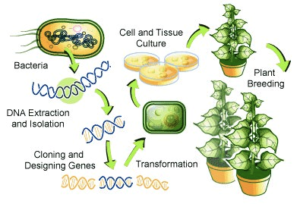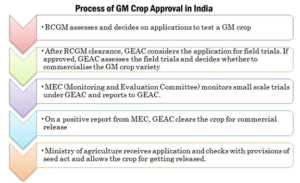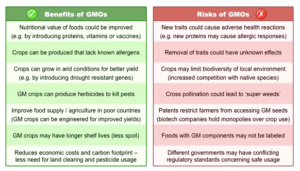A GM crop decision that cuts the mustard.
Relevance
- GS Paper – 2 Government Policies & Interventions.
- GS Paper – 3 Biotechnology.
- Tags : #GM Crop, #GS Paper – 2, #GS Paper – 3, #Biotechnology.
Why in the news?
The environmental release of GM mustard DMH-11 marks a new era in self-reliance and sustainability in agriculture.
Genetically Modified (GM ) Crops
- They are the kind of plants whose DNA has undergone genetic engineering modification in order to confer a new attribute on the plant that does not naturally occur in the species.
- By inserting an alien gene into the seeds to produce the desired results, genetic engineering tries to break down the genus barrier. The foreign gene may be from a plant, an animal, or even a soil bacteria.
- There are GM versions of maize, canola, soybeans, and other crops accessible everywhere.
Genetic Engineering Appraisal Committee (GEAC)
About
- It functions under the Ministry of Environment, Forest and Climate Change (MoEF&CC).
Composition
- It is chaired by the Special Secretary/Additional Secretary of MoEF&CC and co-chaired by a representative from the Department of Biotechnology (DBT).
- Presently, it has 24 members and meets every month to review the applications in the areas indicated above.
Functions
- As per Rules, 1989, it is responsible for appraisal of activities involving large scale use of hazardous microorganisms and recombinants in research and industrial production from the environmental angle.
- It is also responsible for appraisal of proposals relating to release of genetically engineered (GE) organisms and products into the environment including experimental field trials.
- It evaluates research into GM plants and recommends, or disapproves, their release into farmer fields.
GM crops in India
Bt cotton
- Two foreign genes from the soil bacterium Bacillus thuringiensis (Bt) enable Bt cotton, the only GM crop authorised in India, to produce a protein harmful to the common insect pink bollworm.
- Contrarily, Bt cotton is created by introducing a second gene from a different soil bacterium, which enables the plant to withstand the common pesticide glyphosate.
Bt Brinjal
- A gene in Bt brinjal enables the plant to fend off fruit and shoot borer infestations. A gene in Bt brinjal enables the plant to defend itself against fruit and shoot borers.
- The commercial distribution of genetically modified (GM) mustard has previously been delayed by the government due to vehement resistance from NGOs and anti-GMO campaigners.
DMH 11 Mustard
- Genetic modification enables cross-pollination in the DMH-11 mustard, created by Deepak Pental and colleagues at the University of Delhi’s South Campus, in a crop that naturally self-pollinates.
Global variants
- Across the world, GM variants of maize, canola and soybean, too, are available.
Global GM crop cultivation
The top five GM growing countries are
-
- USA (top producer of biotech crops)
- Brazil (second position)
- Argentina
- India
- Canada
- These countries together account for approximately 90% area of the GM cultivation.
- Soybean, maize, cotton and canola with herbicide tolerance and insect resistance are the major GM crops grown around the world.
More crops under GM
- Genetic modification of crops using the available and vast genetic diversity in conjunction with traditional farming has been well documented for increased productivity, contributing to global food, feed, and fibre security.
- According to a report by the International Service for the Acquisition of Agri-biotech Applications (ISAAA) 2020, a total of 72 countries have adopted GM crops either as human food or animal feed, as well as for commercial cultivation (56% of the global GM crop area is in developing countries compared to 44% in industrial countries).
- GM crops have benefited more than 1.95 billion people in five countries (Argentina, Brazil, Canada, India and the United States) or 26% of the current world population of 7.6 billion.
- Bt cotton was commercialized as the first GM crop in India more than 20 years ago, and has been viewed globally as a great success story in terms of economic advantage to farmers and to the nation.
- Globally, genetic modification has expanded its reach, beyond the major four crops, maize, soybean, cotton and canola, to other economically important food crops for various traits such as insect and herbicide resistance, climate resilience and nutritional quality improvement.
- Global economic gains contributed by GM crops (1996-2018) have amounted to $224.9 billion in economic benefits to more than 16 million farmers, 95% of whom are from developing countries. Further, GM food crops, since adoption in 1996 globally have been proven for their biosafety for the last 25 years and more.
Edible oil deficit, a focus on mustard
- India faces a major deficit in edible oils, with 60% of its demand being met by imports.
- Mustard is one of the most important edible oil crops in India; however, its per hectare yield is very low when compared to the global average.
- Thus, increasing the productivity of mustard in the country is vital for the economic well-being of farmers and self-sufficiency in edible oil production.
- Using genetic engineering, extensive research has been carried out at the Centre for Genetic Manipulation of Crop Plants (CGMCP), University of Delhi South Campus, to create a GM mustard hybrid, DMH-11 with higher vigour and yield — this will facilitate an increase in domestic production of edible oils as well as enhanced farm incomes.
- The GM mustard hybrid is based on the barnase/barstar system, which works on the principle of removing male fertility in one parent and restoring it in the offspring.
- The herbicide tolerance gene has been deployed as a selection marker for developing the GM mustard.
- While the use of herbicides in herbicide tolerant (HT) crops has an advantage in terms of saving soil moisture and nutrients, besides effective weed control, the herbicide tolerance gene in GM mustard is primarily used for selecting genetically transformed lines, and for hybrid seed production.
Aiding self-reliance
- The Genetic Engineering Appraisal Committee (GEAC) of the Ministry of Environment, Forest and Climate Change Government of India, made a landmark decision of approving the release of DMH-11 and its parental line for cultivation.
- This will help boost the vibrant genetic engineering research sector in the country and enable the generation of new crop varieties with improved traits.
- As the mustard varieties in India have a very narrow genetic base, the decision by GEAC to allow barnase-barstar-based hybrid production in mustard paves the way for the breeding of mustard hybrids not only for higher yields but also to ensure resistance to diseases and improve oil quality.
- This advancement will benefit farmers by increasing yield per hectare, also leading to an increase in their incomes.
Advantages of GMO crops
- It boosts output and increases farmer income.
- It lessens the use of pesticides and insecticides during farming, which may be excellent steps for improving the availability of food.
- It can feed a population that is growing quickly due to the drastically higher yields.
- Smaller plots of land can yield greater yields.
Disadvantages
- Due to the potential for one organism to be favoured by the “better” qualities created by modifying genes, the production carries significant dangers for the destruction of ecosystems and biodiversity.
- Consequently, it may eventually interfere with how genes move naturally. It raises the expense of farming and makes farming more prone to marketization, which focuses on unethical profits.
- In addition to endangering farmers, transgenic crops also threaten the environment and the trade.
- Inadequate safety evaluations: The majority of the negative consequences from GM crops are not sufficiently captured by the present safety assessments. Additionally, the regulatory framework for GM crops in India has never undergone a full evaluation of the GM risk assessment under Indian conditions.
Way Forward
- The adoption of science-based technologies for crop improvement such as genetic engineering for developing genetically modified (GM) crops as a supplement to conventional breeding methods has become an absolute necessity to address the burgeoning and complex challenge of achieving global food and nutritional security under the fast-changing climate.
- According to the global Food Security and Nutrition Report, 2019, it is difficult to achieve the ‘Zero Hunger’ target by 2030.
- The emphasis needs to be on accelerating the pace of improving crops genetically. In order to increase food production and become self-reliant, we require superior crop varieties and hybrids that provide enhanced yields and wide adaptability across environments, and require fewer inputs of natural resources.
- The advent of the Green Revolution in the 1960s-70s resulted in enhanced food production from a mere 50 million tonnes in 1950-51 to over 300 million tonnes in 2020-21. However, new biotech/GM crops with improved traits are a must in order to mitigate climate change and produce nutrient-dense food.
Source: The Hindu
Mains Question
Do you think the recent recommendation by the genetic engineering appraisal committee regarding genetically modified mustard is fraught with risks? Critically comment.






